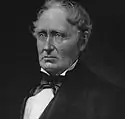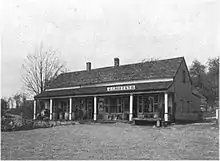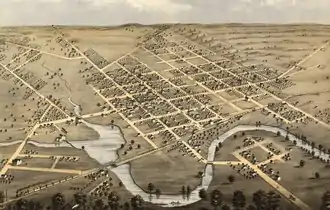Lewis Ludington
Lewis Ludington (June 25, 1786 – September 3, 1857) was a real estate developer and the founder of Columbus, Wisconsin. He was an American businessman of the nineteenth century that had general merchandising stores in Milwaukee and New York state for decades. Ludington was a lumber baron and operated lumber mills and boat docks in Wisconsin to transport his manufactured lumber to New York to be used for construction. He never lived in Wisconsin, but contributed much to its economy.
Lewis Ludington | |
|---|---|
 Lewis Ludington, c. 1855 | |
| Born | June 25, 1786 |
| Died | September 3, 1857 (aged 71) |
| Nationality | American |
| Occupation | Businessman, lumber baron |
| Known for | founder of Columbus, Wisconsin |
Early life
Ludington's father, Henry Ludington, was a soldier in the French and Indian War. Henry married his cousin Abigail on May 1, 1760. They had twelve children, all born in Kent, New York (then known as Fredericksburgh). Lewis was youngest, born on June 25, 1786. His sister, the heroine Sybil Ludington, was the oldest and born on April 5, 1761.[1]
Mid life and career

Ludington was twenty when he partnered with his elder brother Frederick to operate a general merchandising store near their home in Kent, New York.[2][3] He visited Milwaukee in 1838 with his nephew Harrison Ludington and Harvey Birchard of Carmel, New York. They explored the interior of Wisconsin with the idea of purchasing extensive tracts of land from the government for timber. In 1839 the brothers formed a general merchandising store in Milwaukee called Ludington, Burchard & Company. A year or so later, Burchard retired, and the firm became Ludington and Company. Harrison's younger brother Nelson was brought into the partnership at that time. Ludington was the general manager of the company for nearly twenty years. It had a more wide-ranging business compared to other companies in Wisconsin at the time; among its holdings and activities were docks in Milwaukee and lumber mills in Oconto.[4][5]
Ludington also became involved in real estate development in Wisconsin. His connections there were extensive, and he would travel to the state on the schooner Lewis Ludington, which he used to transport harvested lumber across Lake Michigan from Wisconsin and ultimately back to New York state by train.[6]
Founding of Columbus, Wisconsin

Ludington acquired a tract of land in Wisconsin Territory sometime in 1838.[4] He sold 1,300 acres (530 ha) of it to Elbert Dickason in 1839 on a four year land contract.[7][8] Dickason built a cabin on this land acreage on the west side of Crawfish River and dammed up the river for a sawmill and gristmill.[7] He became the first settler to locate in this area, when he brought with him a herd of cattle, some horses, and a few wagons of supplies with hired men. The first winter Dickason spent at this site was severe, as most of his livestock died and he almost ran out of food. In spite of his bad luck, he persisted for the next four years, struggling to complete his log cabin and mill operation. He spent nearly ten thousand dollars doing so. However, he was unable to make enough money from the mills to meet his payments to Ludington and lost all his rights to the property. Ludington took back the property for the back payments and a $200 buyout.[9] There was one other log cabin constructed on this property by Hiram Allen in 1843 not far from the gristmill. Jeremiah Drake succeeded Dickason in becoming the manager of this acreage for Ludington, whose home was in New York state. Drake then built the first frame house on the property known as the mill house being close to the gristmill. Hiram Allen followed later constructing the second frame house on the parcel of land.[10] Drake enlarged the gristmill, and farmers came as far away as Madison, Wisconsin, to have their grain milled there.[7] Drake was in charge of both the sawmill and gristmill.[11]
In July 1844, Ludington designed a community layout for this land that became the basic city plan of Columbus, Wisconsin.[12] Ludington's Plat was the first official evidence of the existence of the city of Columbus.[13] His plat containing Blocks 1 to 9 was recorded in Brown County, Wisconsin, on November 11, 1844.[7][14] The school within Ludington's Plat was built in 1846.[10][15] Columbia County was formed in 1847 from Brown County.[15] There was a Ludington's Addition of Blocks 10 to 13 recorded in Columbia County on August 6, 1849.[14] Ludington made a second addition to the original Ludington's Plat, and it was recorded in the Recorder's office in Portage on October 3, 1850.[16] He deeded some of this land to the Congregationalists later, which they intended to use to build a Methodist church and a Universalist church in the spring of 1855.[17] Ludington, with his son James, helped pioneers to settle and develop the new city of Columbus.[16] Ludington himself never resided in the state of Wisconsin, despite his many contributions to the state, but was a resident of Carmel, New York.[18][19]
Personal life
Ludington married Mary (Polly) Townsend in September, 1812.[3] Their children were Laura, Delia, William, Robert, Charles, Henry, James, Lavinia, Emily, and Amelia.[19] Ludington died on September 3, 1857, at the age of 71 while at Kenosha, Wisconsin.[20]
See also
References
- Johnson 1907, pp. 35–45.
- Johnson 1907, p. 224.
- Downs 1934, p. 180.
- Fuller 1941, p. 411.
- Johnson 1907, pp. 218–225.
- Pelletreau 1886, p. 378.
- "National Register of Historic Places - Bellack, Albert M. and Alice, House". National Park Service. 23 April 2010. p. 2 & 3, section 8. Retrieved 12 January 2020.
- "More Light for Ludington". Wisconsin State Journal. Madison, Wisconsin. October 21, 1875. p. 2 – via Newspapers.com
 .
. - Jones 2016, p. 228.
- Butterfield 1880, p. 666.
- "When Beaver Dam was Young / David S. Ordway recalled early settlement of Dodge County". Daily Citizen. Beaver Dam, Wisconsin. March 1, 2003. p. 29 – via Newspapers.com
 .
. - Johnson 1907, p. 225.
- Jones 2016, pp. 234–235.
- Butterfield 1880, p. 673.
- "Columbia County". Economy, Population and Land Use Survey and Analysis: 1. 1967.
- Butterfield 1880, p. 669-673.
- Butterfield 1880, p. 669.
- The Commission 1994, p. 38.
- Beers 1905, p. 125.
- "Lewis Ludington". The Church of Jesus Christ. 10 December 2019. Retrieved 13 January 2020.
Sources
- Beers (1905). Record of New London County. J.H. Beers & Company.
His partners, who conducted the business (Mr. Ludington never resided in Wisconsin) were, Harrison Ludington, a nephew, afterward governor of Wisconsin, and Nelson Ludington, afterward president of the First National Bank of Chicago.
CS1 maint: ref=harv (link) - Butterfield, Consul Willshire (1880). History of Columbia County, Wisconsin. Western Historical. p. 665.CS1 maint: ref=harv (link)
- Downs, Winfield Scott (1934). Encyclopedia of American biography. American Historical Society.CS1 maint: ref=harv (link)
- Fuller, George Newman (1941). Michigan History Magazine. Michigan Historical Commission.CS1 maint: ref=harv (link)
- Johnson, Willis Fletcher (1907). Colonel Henry Ludington: A Memoir. his grandchildren L.E. Ludington and C.H. Ludington.CS1 maint: ref=harv (link)
- Jones, James Edwin (4 September 2016). History of Columbia County. FB&C Limited. ISBN 978-1-333-47058-6.CS1 maint: ref=harv (link)
- Pelletreau, William Smith (1886). History of Putnam County, New York. W.W. Preston.CS1 maint: ref=harv (link)
- The Commission (1994). Wauwatosa Landmarks. The Commission.
Lewis Ludington, was founder of Columbus, Wisconsin, and his cousin James founded Ludington, Michigan.
CS1 maint: ref=harv (link)